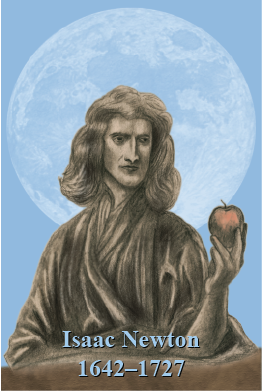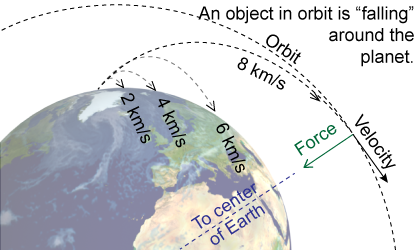|
You learned in elementary school that the Moon orbits the Earth and the planets orbit the Sun because of gravity. This section explains why by showing you how the law of universal gravitation bends the motion of the planets and the Moon into circular or nearly circular orbits. 
|
The apple and the Moon
|
The story goes that Sir Isaac Newton deduced the law of gravitation upon observing an apple fall from a tree. Newton saw that the apple was accelerated as it fell. Thus, he knew there must be a force causing the acceleration. Following Newton’s thinking, let us call this force “gravity.” Experience shows that an apple falling from a tree that is twice as high will be similarly accelerated. It is natural to deduce, as Newton did, that the force of gravity reaches at least as high as the tallest trees. 
|
 Newton’s truly brilliant insight was to question whether the same force of gravity we experience on Earth might reach much further than the tallest trees. Might it reach all the way to the Moon? If so, then the orbit of the Moon about the Earth could be a consequence of the same force that caused the apple to fall. While this may now seem obvious, in Newton’s time it was not. The motions of “heavenly bodies” such as the Moon were divine and not subject to the understanding of humans, nor to laws deduced by mere human minds. Historians of science mark Newton’s explanation of orbits through the law of gravitation as the turning point in Renaissance thought that began the scientific revolution and expanded our understanding of the universe.
Newton’s truly brilliant insight was to question whether the same force of gravity we experience on Earth might reach much further than the tallest trees. Might it reach all the way to the Moon? If so, then the orbit of the Moon about the Earth could be a consequence of the same force that caused the apple to fall. While this may now seem obvious, in Newton’s time it was not. The motions of “heavenly bodies” such as the Moon were divine and not subject to the understanding of humans, nor to laws deduced by mere human minds. Historians of science mark Newton’s explanation of orbits through the law of gravitation as the turning point in Renaissance thought that began the scientific revolution and expanded our understanding of the universe. 
|
 How can “falling like an apple” cause the Moon to orbit? Suppose we fire a cannon up into the sky. The cannonball eventually falls to Earth due to the downward acceleration of gravity. As we increase the velocity of our imaginary cannon, the cannonball travels further and further before hitting the ground.
How can “falling like an apple” cause the Moon to orbit? Suppose we fire a cannon up into the sky. The cannonball eventually falls to Earth due to the downward acceleration of gravity. As we increase the velocity of our imaginary cannon, the cannonball travels further and further before hitting the ground. 
|
Newton reasoned that, given sufficient velocity, the curvature of the “falling” cannonball would match the curvature of the planet itself. In essence the “ground” would fall away at the same rate as the cannonball. Newton realized that this path is precisely what we call an orbit. This intuitive leap led to a concept that gravity is a universal force that any object with mass (such as the Earth) exerts on any other object with mass (such as you or the Moon). 
|

